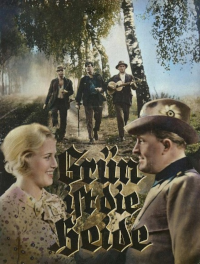
Original Title: Grün ist die Heide. (Der geheimnisvolle Wildschütz.) Folk drama 1932; 88 min.; Director: Hans Behrendt; Cast: Theodor Loos, Camilla Spira, Peter Voß, Hugo Werner-Kahle, Gerhard Bienert, Paul Beckers, Fritz Kampers, Karl Blume, Fritz Odemar, Alfred Beierle; R. N.-Tobis-Klangfilm.
Lüneburg Heath. The forest personnel fail to apprehend a poacher. A veterinarian discovers that it’s her father. A young forester spares him for her sake. On the day before his departure to the city, the less skilled hunter is fatally wounded by a trapper. His daughter ends up with the hunter.
Summary
In a heath village, a poacher wreaks havoc in the area. The head forester and Walter, his young assistant, are futile in their efforts to track him down.
During one of his hunting trips, Walter meets Grete Lüdersen, the daughter of a former estate owner, who works as a veterinarian in the heath village. The two young people take a great liking to each other, but Grete makes a terrible discovery that threatens to abruptly end their connection: Her father has been swept away by the passion for hunting and has resorted to poaching, narrowly escaping detection by the forester.
Grete insists that her father move with her to the city. Shortly before this plan is put into action, on the evening of the heath shooting festival where Grete dances with Walter for the last time, news spreads through the village that the dangerous poacher has finally been apprehended.
Horrified, Grete leaves the festival and rushes to the forest lodge, fearing that her father has been caught and arrested during another forbidden hunting trip. To her relief, she recognizes the captured poacher as a notorious trapper and thief whom her father helped apprehend.
Walter Jerven’s review in Film Kurier No. 291 (December 10, 1932)
In the book Grün ist die Heide by Hermann Löns, which has achieved a significant number of editions, there are beautiful stories of lonely individuals, hikers, blossoms and trees, animals, and the passion of hunting.
It is a folk book, and the film, inspired by and following the poetic model of Hermann Löns, is a folk film.
This means that the events unfold in a straightforward and realistic manner, and the people and events depicted in the film are genuine.
There are no detours into the realm of operetta-like fantasy.
The film’s narrative encompasses both the actions of the characters and the processes of nature.
It tells a magnificent story of the destiny of a poacher, whose passion is noble and instinctual, unrelated to the cunning greed of those who harm the forest and resort to snares and traps.
The poacher’s daughter plays a role in the story, healing sick animals and eventually discovering that her father is also in need of healing. She urges him to move to the city before becoming a victim of the new forester. However, during a confrontation with a trapper, the area is surrounded, and a bullet strikes the poacher.
The story is told in a straightforward and simple manner, interweaving the fates of the characters with those of the heath and the forest.
Considering that popular films have previously focused exclusively on the grounded Bavarian people, it is even more delightful to witness a different landscape of Germany and its unique people blooming on screen.
Germany is rich in folk traditions, colorful with the customs and manners of down-to-earth people. If this film helps the film industry open its eyes to the diversity of our homeland, it fulfills a special mission.
Director Hans Behrendt skillfully avoids overly dramatic paths, benefiting the film by combining poetry and prose. He also acknowledges that the heath is not always a depiction of solemn and self-contained decisiveness but also smiles when it blooms.
The trio of the three Walz brothers, led by Fritz Kampers with dry humor, brings forth such smiles. Mischievous and, when necessary, ironic, their “wingmen” Paul Beckers and Karl Blume, the composer of the popular Heidelied, contribute to the film’s success.
Theodor Loos portrays the poacher with restraint yet impactful methods, creating a well-defined character. Camilla Spira exudes exceptional charm through her simple warmth. Hugo Werner-Kahle embodies a weathered head forester, inseparable from his famous Dachshund companion. Fritz Odemar delivers a pleasantly unpretentious and delightfully caricatured but true-to-life portrayal of a forestry councilor, much to the enjoyment of the audience. Peter Voß portrays a likable lover who deviates from clichés.
The landscapes and scenes captured by Ewald Daub’s camera are beautiful and unadorned. The musical elements combine folk-like songs by Karl Blume and melodic accompaniment by Walter Ulfig and Grete Walter.
It comes as no surprise that the film received much applause and many accolades.